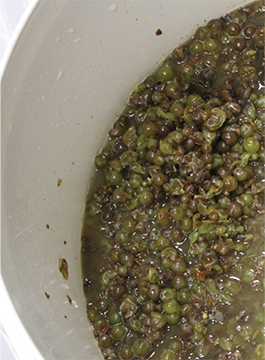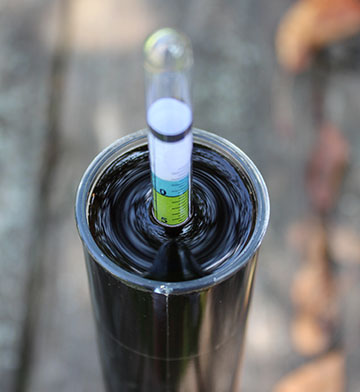 Your wine undergoes many changes on its way to the bottle. One process that is sometimes given little attention is adjusting the must. We may accept the grapes or juice that we receive, ferment them, and either tolerate what we get or try to adjust it afterwards. That approach overlooks the tremendous power available to us for intervening in the characteristics of the wine by addressing the must before fermentation even starts. Read on for some tips and tricks that can allow you to shape your final product from its earliest days.
Your wine undergoes many changes on its way to the bottle. One process that is sometimes given little attention is adjusting the must. We may accept the grapes or juice that we receive, ferment them, and either tolerate what we get or try to adjust it afterwards. That approach overlooks the tremendous power available to us for intervening in the characteristics of the wine by addressing the must before fermentation even starts. Read on for some tips and tricks that can allow you to shape your final product from its earliest days.
Keep in mind, though, that adjusting the must is just one important stage in the overall journey of making wine. Once you have identified the grapes or juice that you will work with, the first step — and a very important one — is to develop a vision of the wine you intend to make. Become one with your wine! A good concept of where you want to go with your wine can inform many of your later decisions as you bring it along. Red, white, or pink? Big and bold or elegant and refined? Easy drinking with a moderate alcohol level or a high-octane fruit bomb? These and many other characteristics can be influenced by must adjustment, but you need to know where you are trying to go to apply them successfully.
Once you have a concept in mind, you can give thought to what you can adjust, how to assess it, how to do it, and evaluating the results. Conceive, measure, adjust, ferment, and then taste. After that, and beyond the scope of this article, you can apply further adjustments if you still have not quite hit your concept wine.
What Can Be Adjusted
The features amenable to adjustment at the must stage of winemaking cover a very wide range. The most important should be considered for every wine. Other, lesser influences are entirely optional depending on your vision for your wine and your desire to optimize it. The first of the major factors is the alcohol level (ABV, or percent alcohol by volume). Since that is directly produced from the sugar concentration in the must, that is where the adjustment begins. The next major factor is the titratable acidity or TA. Since that goes hand-in-hand with pH, the hydrogen ion concentration, they should be addressed together. Beyond these major factors, you have the opportunity to influence the tannin level, fruit aromas, body and mouthfeel, and oak flavors.
If you grow your own grapes, some of your conceptual targets can start even before the crush. Measuring sugar, acid, and pH in the vineyard prior to harvest can help you start close to your ideal objective. If you purchase grapes from a grower, you may have some influence over the harvest date and the corresponding harvest parameters. If you buy grapes already picked (or juice) you will begin your work at the must assessment stage (see sidebar at the end of this article).
Here are the main ways that you can adjust your must:
Sugar: If your Brix measurement on the crushed must came in lower than your target, you can add sugar. Since Saccharomyces yeasts tend to be glucophilic (preferentially processing glucose as a food source), adding glucose is the most direct adjustment. Glucose, also known as dextrose, can be found at home winemaking shops in the form of corn sugar. Note that this is not “high fructose corn syrup” that gets so much bad press. On the contrary, it is just glucose and is very readily fermentable. Since Brix is defined as percent sugar by weight, that is how you can calculate an addition. For instance, if your Brix is 21° and your target is 23°, you need to add sugar equal to two percent of the weight of your grape juice (23 – 21 = 2). For red wine must, I usually estimate that I will get about 6 gallons (23 L) of juice per 100 lbs. (45 kg) of grapes. I also estimate that grape juice, with its high sugar content, weighs about 10 lbs. (4.5 kg) per gallon (3.8 L) since pure water weighs 8.3 lbs./gal. (1 kg/L). So for 100 lbs. of grapes in this situation, 100 lbs. x 6 gallons/100 lbs. = 6 gallons of juice in the must (45 kg x 23 L/45 kg = 23 L) 6 gallons x 10 lbs./gal = 60 lbs. of juice in the must (23 L x 4.5 kg/3.8 L = 27 kg) so, 2% of 60 lbs. is 0.02 x 60 = 1.2 lbs of sugar to add (0.02 x 27 kg = 0.54 kg).
Weigh out the sugar and dissolve it in a small amount of warm must, allow to cool, and add to the whole must with stirring. For sugar additions to white wine juice, use the figure of 10 lbs./gal. (4.5 kg/3.8 L) and calculate the addition directly. Regular table sugar (cane or beet sugar) can be used instead of corn sugar, but since it is in the form of sucrose (a 12-carbon sugar made up of a glucose unit linked to a fructose unit) it is a bit more difficult for the yeast to process.
Water: If your Brix number is higher than your target, add water (preferably distilled or reverse osmosis treated, to avoid adding minerals). In this case, first estimate the gallons (liters) of juice as described above for red wine or measure it directly for white juice. Then set up the following equations to determine the water to add:
(volume of juice) x Brix of juice)/Desired Brix = Needed volume after adjustment and, Needed volume after adjustment – volume of juice = water to add
As an example, suppose you have 6 gallons (23 L) of juice at 26° Brix and you want it at 24° Brix:
(6 gal x 26°)/24° = 6.5 gal (23 L x 26°/24° = 25 L) and, 6.5 gal – 6 gal = 0.5 gal to add (25 L – 23 L = 2 L)
Match your water temperature to the must and stir the water in. A note of caution with red wine must: Very high Brix musts are often found to contain shriveled grapes and raisins. As these soak over a period of a day or two, additional sugar may soak out of them. So measure your initial Brix, add needed water, and measure again. Then the next day, measure again to make sure the must has not “soaked up” to a higher Brix level, requiring a second water addition.
Acid: If the TA is lower than your target, the adjustment is simple. Since TA is measured as tartaric acid and that is the acid you want to use, you just need to estimate your volume and weigh out the acid for addition. Because the TA results are in metric units, it is easiest to go with those for the addition calculation. For example, suppose you have juice at 0.4 g/100 mL (4 g/L) and you want 0.6 g/100 mL (6 g/L). Plan your addition in grams per liter: 6 g/L – 4 g/L = 2 g/L to add. Estimate your juice yield as described earlier, and convert to liters: 6 gallons = 23 L. Calculate the tartaric acid addition: 23 L x 2 g/L = 46 g to add.
Dissolve the tartaric acid in a small amount of distilled water and stir it into the must.
A word of caution here: I specify tartaric acid because citric acid is strongly discouraged in winemaking from grapes, particularly red winemaking, as citric acid is metabolized into acetic acid by lactic acid bacteria. Tartaric acid has become quite expensive compared to citric, but that does not mean that citric acid is a good substitute for tartaric acid.
Lowering the acid level is a bit more complicated. You cannot simply take the acid out, so you need to neutralize it with a basic (alkaline) material. My preferred adjustment chemical is potassium bicarbonate, also available at home winemaking supply stores. Adding it at 1 g/L will reduce TA by a corresponding 1 g/L. Do not try to adjust more than 2 g/L, as a salty or bitter taste may result. The calculation is the same as our example for addition, except you are adding potassium bicarbonate instead of tartaric acid.
Since you can further adjust the TA later in the winemaking process, you may wish to make only a 1⁄2 or 2⁄3 addition of your calculated acidification or deacidification and wait to make a final adjustment after. For more information about making acid adjustments later in the winemaking process, check out Daniel Pambianchi’s article “Mastering Wine Acid Balance” from his “Advanced Winemaking” column, at: https://winemakermag.com/technique/mastering-wine-acid-balance.
Also, you can expect a decrease in TA if you perform MLF, and also from cold stabilization. Note that to lower pH is the same process as adding acid and raising pH is the same process as adding potassium bicarbonate. The pH does not change linearly with the additions, so calculate for TA first, then make the needed adjustment. If a pH target would require going significantly outside of the TA target range, I recommend using TA as your primary guide (for taste) and dealing with your pH concerns (for stability) later.
Nutrients: As noted, this must adjustment is more for general fermentation success rather than altering the characteristics of the wine. For further guidance, see the “Techniques” column “Choosing and Using Yeast Nutrients” in the August/September 2016 issue of WineMaker.
Tannins: If the juice seems in need of more tannic “grip,” you can add tannins to the must in several forms. You can use oak chips or oak dust, which may also add oaky flavor components. You can add grape tannins or specialized fermentation tannin preparations like FT Rouge Soft and FT Blanc Soft from Scott Laboratories. Use rates vary from less than 1 g/gal. (0.26 g/L) in white juice to as much as 4 g/gal. (1 g/L) in red must. Follow the instructions from the manufacturer for any product you choose. For any addition, calculate your total desired amount and weigh it out. For white juice, add with mixing when you rack the settled juice off of the fruit lees.
For red must, sprinkle the product on top and then mix it in at the time of the first punchdown.
Mouthfeel: While tannin and oak additions will have some positive effects on mouthfeel, you may be able to get further enhancements by adding specific inactivated yeast nutrient products to the must. Materials like OptiMUM White and Opti Red from Lallemand are used at rates from 1 to 2 g/gal. (0.26 to 0.52 g/L). Add at the same time as the tannin products just described.
Aroma: For enhanced aroma in your finished wine, it is more about liberating what is already in the grapes than about adding aromas themselves. Many aroma precursors in wine grapes are bound to sugar molecules in a non-aromatic form. Some of these compounds are also found in the skins of the grapes. To enter the wine, they need to be cleaved off by enzymes. While this process occurs naturally with yeast enzymes during red wine fermentation, it can be enhanced. To have any chance with white wine, it requires enzymatic activity on the crushed grapes, prior to pressing and removal of the skins. Add enzymes such as Lallzyme EX or Enartis Zym Color Plus to the crushed grapes about 15 minutes after your initial addition of sulfites. Use rate is about 10 g/1,000 lbs. of grapes (10 g/454 kg). Mix the weighed-out enzyme powder with a small amount of distilled water and stir into the must. These enzyme additions can also improve color extraction in reds and mouthfeel in both reds and whites.
Get Adjusted
After treating with sulfites and making your various must adjustments, it is time to inoculate with your chosen yeast strain and ferment your must! Although at this point we are done adjusting the must, keep that initial concept of what you want in the finished wine in mind throughout fermentation and aging. As you observe, smell, and taste your wine at every stage, other adjustment opportunities will come up. Of course be sure to take lots of notes; you may hit a home run with your initial adjustments and need to make no further changes (other than sulfite maintenance). But even if you don’t, you can still get to home plate one base at a time by applying additional corrections as you go along, all the way throughout the process —right up to bottling day. But that’s another story!
Must Assessment (sidebar)
Before you can make any adjustments, you need to know where you stand with your must. It’s time to assess!
Sugar measurement is your critical first step in assessing your must. If you are working with fresh grapes, for your initial evaluation, you can put 20 or 30 grapes in a small plastic zipper-style bag and pop them with your fingers. Mix the juice well and check it with a refractometer. If your goal is a lower alcohol wine, you will be looking for a number between about 19 and 21 °Brix. Applying a common rule-of-thumb that I use, you can multiply the starting Brix number by 0.55 to estimate your final ABV. This range would predict 10.5 to 11.6% ABV. On the other hand, if you are looking to make a blockbuster wine, you will want a Brix level of 24 to 26°, to produce an estimated 13.2 to 14.3% ABV. After crushing and soaking, the Brix level may change. Since the refractometer cannot be used reliably once alcohol is present, you will be monitoring your fermentation with a hydrometer. Begin using that as soon as you have crushed (or crushed and pressed for white wine). Because the refractometer and hydrometer measure sugar by completely different technologies, they may not exactly agree. Since you need to use the hydrometer later anyway, just switch to that technique and move on.
The next critical measurements are the linked values of TA and pH. For the TA titration, you can use a simple kit that employs a phenolphthalein visual endpoint, a sophisticated titration setup with a buret and a pH meter, or a special-purpose meter from companies like Vinmetrica or Hanna. If you have one of the meter systems, it probably includes a pH meter already. If not, you will want to get that separately. For most red wine musts, you will want a TA range from about 0.6 g/100 mL (equivalent to percent, also expressed as 6 g/L) to about 0.8 g/100 mL. Much lower than this range and the wine will likely be perceived as “flabby” and much higher will be too tart. Since we like a brighter flavor profile in most white wines, the range in the juice will be more like 0.7 g/100 mL to 0.9 g/100 mL. These values are slightly higher than the levels desired in the finished wine because TA is known to decline during fermentation (both alcoholic and malolactic, if done), cold stabilization, and aging. The pH has more to do with the ultimate stability of the wine, whereas the TA is critical to the flavor. Desirable pH ranges for red and white wine are about 3.3 to 3.6 and 3.1 to 3.4, respectively.
There is one other must analysis that I recommend if you have access to a wine testing laboratory: Nutrients. Unfortunately, there are no home tests for ammonia nitrogen and primary amino nitrogen, the two critical values needed to help you decide on a nutrient program. Those must adjustments are primarily in the range of assuring a clean, complete fermentation and are not specifically directed at the flavor profile of the wine.
To assess other characteristics amenable to must adjustment, you will need to rely on tasting the juice, since numeric targets for these parameters are not readily available. For this exercise, I recommend that you get a helper (or two) with a good palate so you can talk over your perceptions and get another point of view. Taste the juice for its tannic profile or astringency, trying to mentally subtract out the very high sweetness. You may also be able to gain some perception of mouthfeel from the juice as well as evaluating the aroma.
If you are fortunate enough to make wine from the same source of grapes every year, use the results and winemaking notes of previous vintages to guide your choices about tannins, mouthfeel, aromas, and any benefits of oak addition.







